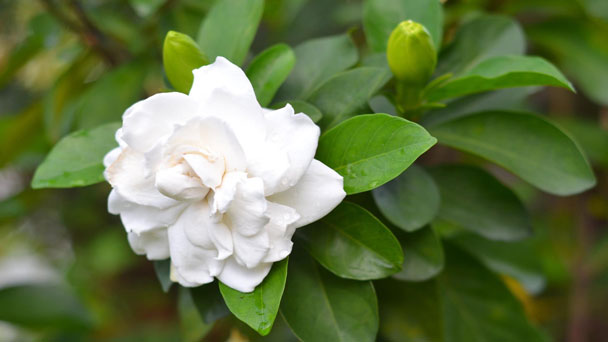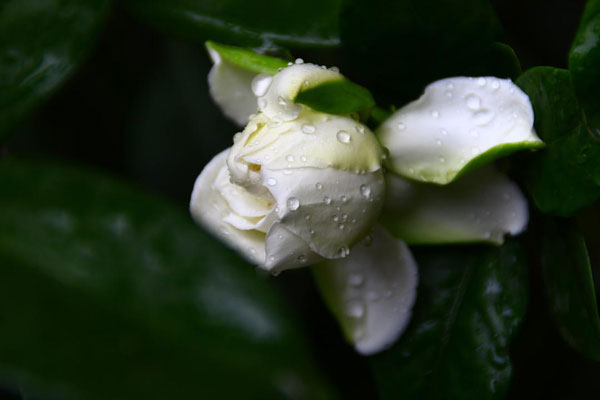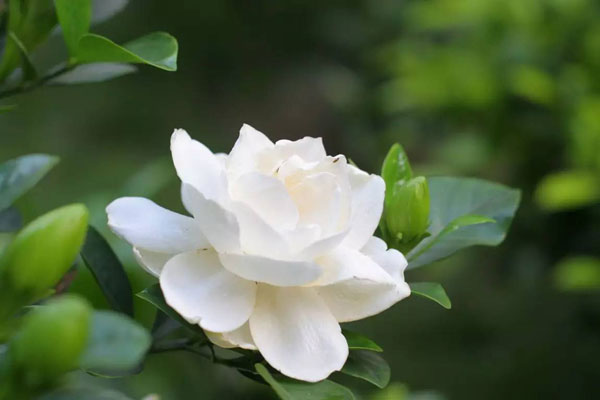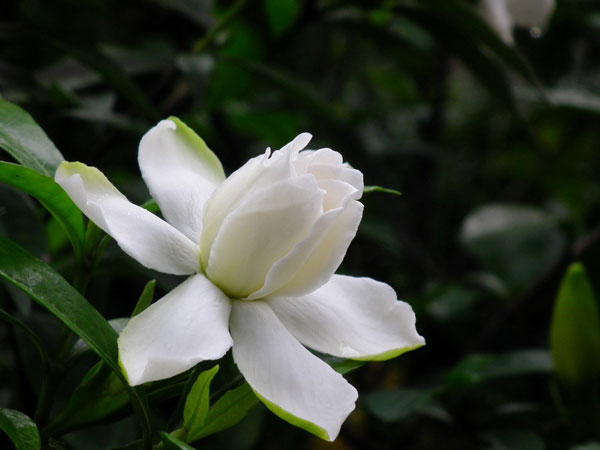Cape Jasmine (Gardenia Jasminoides) Care & Propagation Guide
Written by Iris
Feb 08 2023

After the Cape Jasmine (Gardenia Jasminoides) blooms, the flower is very beautiful and has a light fragrance, which is very attractive. The leaves are evergreen all year round. It is a very good ornamental flower and has a very high ornamental value. After the gardenia flower is defeated, you should pay attention to pruning and caring for it, so that it can continue to bloom and bloom continuously. So, how to grow and care for Cape Jasmine? This article will tell you the answer.

Position your plants somewhere they can receive direct morning sun but shielded from harsh afternoon sunlight. A little light shade they do appreciate!
A high degree of humidity is also essential when flower buds are forming. To achieve this, stand the pots on trays of moist pebbles or peat moss and spray plants at least once a day with fine mist-spray, using water at room temperature. But try not to wet the flowers if the plants are in bloom, because water on the petals causes discolouration.
Fresh, moist (humid) circulating air is a necessity, especially during the winter. Hot, stale or dry air can cause fungal issues. Keep this plant away from radiators and avoid draughts.
Gardenias do enjoy humidity. Unfortunately, most homes simply contain dry air. You could buy a fancy pebble tray, but you can make your own, more economical version that will work just as well. Simply get a large plastic plant saucer. Fill it about 3/4" deep with gravel. Add water almost to the tops of the pebbles. (You don't want your plant sitting in water at any time.) The evaporation from this saucer will keep at least the immediate area around your plant comfortably moist. Misting the Gardenia plant is not recommended, as this may cause problems with fungal leaf spot.

How to Grow Cape Jasmine (Gardenia Jasminoides)Cape Jasmine Propagation with SeedsCape Jasmine Propagation with Stem CuttingsCape Jasmine Propagation with LayerHow to Care for Cape Jasmine (Gardenia Jasminoides)Cape Jasmine Lighting SoilWateringTemperature & HumidityFertilizerPruningPests & DiseasesVarieties of Gardenia Jasmine
How to Grow Cape Jasmine (Gardenia Jasminoides)
Cape Jasmine Propagation with Seeds
- More in the spring, spring is suitable for plant growth and germination. Or it can be planted around the autumnal equinox in the fall.
- It will be ready to seed seeds mixed with fire ash, and then evenly sow the soil, and then with fine soil or fire soil cover, finally cover the grass water, in the growing season of the seed to often keep the soil moist, for the sake of seedlings.
- The seedlings of cape jasmine come out about 20 days after sowing. After the seedlings come out, the grass cover is removed. When the seedlings grow 2 to 3 true leaves, the seedlings are kept in the container without weeds growing.
- Appropriate topdressing, 2 ~ 3 times in the first year of autumn sowing, 1 time in the second year of spring, summer, and autumn; Spring sowing in the spring, summer, autumn, winter each for 1 time. When the seedling height is more than 30cm, it can be planted. When the seedling height is 30cm, it can be planted when the spring sowing is the next spring.
Cape Jasmine Propagation with Stem Cuttings
- Select a healthy, semi-hard stem that grew in the current year. Look for a stem that's green and sprouting leaves. It should also still be flexible. It's okay to take more than 1 cutting from the plant, as long as you don't cut away more than one-third of the plant.
- Taking more cuttings from your jasmine increases your chances of successfully growing a new plant. Use small pruning shears to cut 4 to 6 inches (10 to 15 cm) of stem. It's best to cut the stem just below a leaf. The stem is more likely to sprout healthy roots if you cut right below a leaf node. A leaf node is the nub that the leaf grows from. You can also use a sharp knife or pair of sharp scissors.
- Remove the leaves from the bottom of the cutting. Make sure that you don't plant any leaves beneath the surface of your potting soil. However, the cutting is more likely to root if the top few leaves are left on the stem. Leave a few leaves at the top of the cutting while removing most of the leaves from the bottom. You can cut the leaves off the stem or pluck them with your fingers. Removing most of the leaves helps to balance the growth between roots and leaves.
- Deadhead any flowers from the cutting. This helps to ensure that your cutting will grow healthier. Flowers naturally try to seed and will take nutrients from the rest of the plant to do so. Additionally, dying flowers will mold, damaging the rest of the cutting. You can cut the flowers off or pinch them off. Don't take cuttings from stems that are in bloom. Even if a flower is cut off, it will still be in the bloom stage.
Cape Jasmine Propagation with Layer
- Select robust branches, it is best to be 25 ~ 30 cm long branches for laminating, such as the selection of branches that have tri pronged branches, so you can be laminated at the fork. After propagation, you can get three seedlings.
- The mother plant selected lower branches of the column bent, and then buried in the soil, shoot exposed, and fixed with bamboo, so that its upright growth, generally after 20 ~ 30 days can take root. It can be separated from the mother plant in June, until the spring of the next year can be divided, or directly on the pot.

How to Care for Cape Jasmine (Gardenia Jasminoides)
Cape Jasmine Lighting
Gardenia jasminoides needs bright light to grow best. However, sunlight shouldn’t be direct. The direct sunlight of the summer in cooler regions can scorch the plant.Position your plants somewhere they can receive direct morning sun but shielded from harsh afternoon sunlight. A little light shade they do appreciate!
Soil
The preferred soil for Gardenia jasminoides should be rich, acidic, moisture-retentive and well drained. Use a soil which has 6 or higher pH. This is a calcifuge (lime hating) plant, which means it does not tolerate alkaline soil. If the soil is not acidic enough, then many plant problems can occur.When planting them, keep a distance of at least 1m (40 inch) between each plant.Watering
This is a plant that will require you to give it an average amount of water each week. It will not require a lot, and sometimes, the rain will provide the plant with enough water, but if you have it potted to grow inside your home, then this plant will need to be watered at least biweekly. To make sure that it is getting enough water, test the soil before you give it more water. The soil should be dry to the touch so that giving it more water does not cause root rot.Temperature & Humidity
The key to success in bringing Gardenia jasminoides into flower is to maintain a steady temperature of 16-17°C (61-62°F) during the period when flower buds are forming; a sudden change in either direction is practically certain to cause the buds to drop off. When plants are not forming flower buds, the range can be that of fairly normal room, between 15-24°C (60-75°F).A high degree of humidity is also essential when flower buds are forming. To achieve this, stand the pots on trays of moist pebbles or peat moss and spray plants at least once a day with fine mist-spray, using water at room temperature. But try not to wet the flowers if the plants are in bloom, because water on the petals causes discolouration.
Fresh, moist (humid) circulating air is a necessity, especially during the winter. Hot, stale or dry air can cause fungal issues. Keep this plant away from radiators and avoid draughts.
Gardenias do enjoy humidity. Unfortunately, most homes simply contain dry air. You could buy a fancy pebble tray, but you can make your own, more economical version that will work just as well. Simply get a large plastic plant saucer. Fill it about 3/4" deep with gravel. Add water almost to the tops of the pebbles. (You don't want your plant sitting in water at any time.) The evaporation from this saucer will keep at least the immediate area around your plant comfortably moist. Misting the Gardenia plant is not recommended, as this may cause problems with fungal leaf spot.

Fertilizer
Established plants can benefit from fertilization. Take a visual inventory of your landscape. Trees need to be fertilized every few years. Shrubs and other plants in the landscape can be fertilized yearly. A soil test can determine existing nutrient levels in the soil. If one or more nutrients is low, a specific instead of an all-purpose fertilizer may be required. Fertilizers that are high in N, nitrogen, will promote green leafy growth. Excess nitrogen in the soil can cause excessive vegetative growth on plants at the expense of flower bud development. It is best to avoid fertilizing late in the growing season. Applications made at that time can force lush, vegetative growth that will not have a chance to harden off before the onset of cold weather.Pruning
When it comes to pruning cape jasmine, it must be done during the time of the year when they are finished blooming and go dormant. If you do this, it will promote branching on the plant and create a more compact growth. If there are any damaged limbs or infested branches, they should be cut away immediately. If you need to propagate your plant, it can be done using a seed or a small cutting.Pests & Diseases
Cape jasmine is plagued by a plethora of problems and pests. Watch for insect pests such as aphids, weevils, mealybugs and scale insects, as well as nematodes, spider mites and whiteflies. Root and crown rot infections and sooty mold can damage cape jasmine plants, warns the University of California at Davis IPM. Sooty mold is often a byproduct of infestation by scale insects, mealybugs and aphids, which exude a sticky substance called honeydew. Honeydew attracts ants and also serves as a growth medium for sooty mold.
Varieties of Gardenia Jasmine
- Gardenia jasminoides ‘Belmont’ which is densely bushy plant and bears large, fragrant, many petaled, white flowers that turn cream coloured as they age. This variety is often sold as cut flowers by florists.
- Gardenia jasminoides ‘Fortuniana’ (Gardenia jasminoides ‘Florida’) is a less bushy plant with medium size, rather waxy, snowy-white, many petaled flowers that turn yellowish with age.
- Gardenia jasminoides ‘Veitchii’ has a dense growth and medium size, many petaled flowers which normally remain pure white. This variety can be brought into flower in early winter by dis-budding (having their flower buds picked off at an early stage) throughout summer and early autumn.
- Gardenia jasminoides ‘White Gem’ is a dwarf variety reaching only 60cm (24 inch) tall. It is one of the most common species of Gardenia for growing indoors.
- Gardenia jasminoides ‘Radicans’ has an upright form, making it a favorite for shaping a gardenia tree. It is perfect for creating a Gardenia bonsai.
Latest Updated
- Cape Jasmine (Gardenia Jasminoides) Care & Propagation Guide
- Reasons Hydrangea Leaves Turning Yellow - Find the Solutions
- Panicle Hydrangea Care & Propagation Guide
- Lemon Tree Leaves Turning Yellow & How to Save It
- Why Are Your Gardenia Leaves Yellow - How to Fix
- Why Are My Tomato Leaves Turning Yellow - 7 Reasons & Solutions
- How To Save Your Sunburned Tomato Leaves
- Beefsteak Tomatoes Grow & Care Guide
- Beefsteak Tomatoes Profile
- Why Are My Orchid Leaves Turning Yellow - Common Causes & Fixs
Popular Articles
- Winter maintenance of Antirrhinum Majus
- How to Grow Terminalia Mantaly Tree
- How to Grow and Care for Crossostephium Chinense
- How to grow Antirrhinum Majus in spring
- Peristeria Elata (Dove Orchid) Profile: Info & Care Guide
- Underwatered Snake Plant (Sansevieria Trifasciata) - Signs And How To Fix
- How to Care for Brazilian Jasmine Plant (Mandevilla Sanderi)
- Rosa Chinensis (China Rose): Plant Growing & Care Tips
- How to Grow & Care for Graptopetalum Purple Delight in Summer
- How to Care for Baby Sun Rose (Aptenia Cordifolia)